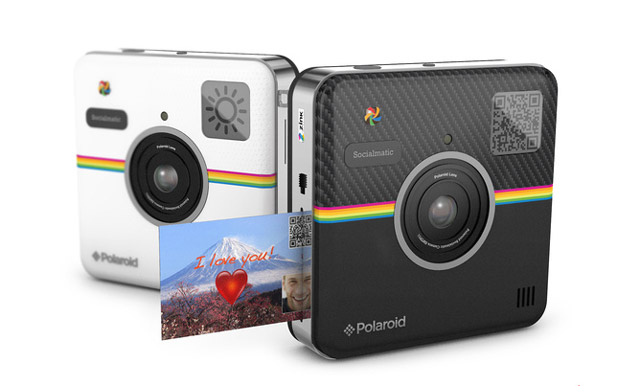
Everyday objects with network connections that can collect and share data or be remotely controlled — the Internet of things (IoT) — promise to transform the way we interact with the world around us by fusing the physical and digital into what is gradually being referred to as “phygital”.
As an example, take the new Socialmatic camera by Polaroid. The camera updates the original instant-print Polaroid film camera developed in the 1960s to a digital camera with built-in printer that is also network-connected to share images directly to social media sites. In a somewhat knowing, self-referencing way, the camera is shaped like a giant Instagram logo — the original photo app whose “retro” filters re-popularised the look of film to a generation raised on digital.
Is the appeal of analogue in a digital world simply nostalgia for the old days, or a growing trend?
With the Polaroid camera it’s both. The concept of such a physical-digital hybrid camera was initially conceived in 2009, developed further in 2012, unveiled in May 2013 and is due for release in 2015. Why has it taken so long to come to fruition? Perhaps because it’s only in recent years that the approach of the IoT has reinvigorated people’s interest in the appeal of hybrid analogue-digital objects.
The hybridisation of physical and digital elements can be found in other fields, such as in videogames and toys. In fact, physical game pieces are becoming a popular addition to traditional ones and mobile digital gaming, such as real-world game character figurines like Captain Jack Sparrow. Large game studios such as Disney Infinity and Activision are merging their videogame and toy divisions into exciting seamless experiences through game titles such as Skylanders and Disney Infinity.
These games include collectible real-world figurines that can be imported (through digital imaging) into the videogame, so that characters from Skylanders or Disney can come alive in the videogame world. In mobile games such as Tangible Play’s Osmo, real-world objects are used in combination with an iPad to bring children back towards physical play, solving puzzles with blocks or by playing word games with physical letter tiles.
These games have been a terrific success — Skylanders has sold 175m toys and reached the top 20 highest-selling videogame franchises of all time, with similar results for Disney Infinity and Osmo. The appeal for physical toys in a digital game world has given rise to a whole new genre of hybrid “phygital” games.
The fact this has managed to win over digitally minded youngsters shows real promise for its appeal to a more technologically sceptical older generation.
The appeal of analogue
But what makes our experience with the analogue world and physical objects so magical even in today’s digitally dominated world?
Looking back at early childhood development, it’s through touch we first perceive and make sense of the world around us. The physical, material nature of objects, their colour, texture, shape, size, weight and smell engage our senses. That is why many still prefer actual books to e-books: it’s the warm feel of paper as opposed to the coolness of plastic and metal. The fresh aroma of a new book, or the pungent scent of an old volume, something simply absent from its digital counterpart. The rustle of turning pages compared to the clicking of an e-reader. All-in-all, a truly multisensory experience.
Even in a marketplace increasingly dominated by online shopping, physically interacting with products is still relevant and why physical stores still have an important role to play. For example, major brands such as Apple retain high street stores because the physical experience and interaction with the company’s products remains at the heart of the shopping experience.
And it is here that analogue’s appeal wins out: by fulfilling our need to make the intangible tangible, in order for to meaningfully interpret the world around us.
Being tangible also means being able to easily share something. Certainly this is true of printed photos, passing them around to spark conversation or attaching a treasured image to the fridge — things digital photos cannot do. Making play physical encourages collaboration between the generations, where games with physical pieces can be enjoyed by young and old without the need to master any digital skills.
We live in an increasingly digital age, but despite this — perhaps because of this — the yearning for analogue is re-emerging. Despite all the progress possible through increased digitisation of the world, the physical is deeply imprinted in our biological and psychological makeup, and is how we make sense of our world. It’s here to stay.
 Emmanuel Tsekleves is senior lecturer in design interactions at Lancaster University
Emmanuel Tsekleves is senior lecturer in design interactions at Lancaster University- This article was originally published on The Conversation




